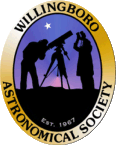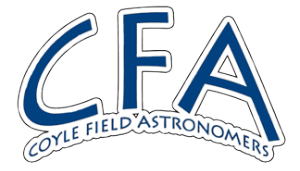Black Brant Rocket Launch
October 7, 2015
On October 7, 2015, at 7:07 pm EDT, a Black Brant IX sounding rocket was launched from the NASA facility at Wallops Island, Virginia. This is the view at 7:07:25 pm (as reported by the camera's internal GPS-set clock) from Coyle Field in Woodland Township, NJ, about 150 miles north-northeast of Wallops. The rocket's ascent was visible as a moderately bright orange dot rising above the southwestern horizon. There was no rocket trail visually; however, the relatively long exposure left a trail in the picture. Taken with a Canon 6D digital SLR camera (on a fixed tripod) and a Canon 24 to 105 mm f/4L zoom lens set to 28 mm focal length (then cropped significantly to highlight the trail). Exposed 15 seconds at f/11, ISO 100, which resulted in unintended underexposure for the moving dot of rocket exhaust, which had a guesstimated magnitude around zero. The rocket trail is heading upwards towards Shaula and Lesath (Lambda and Upsilon Scorpii), the pair of stars that mark the stinger of Scorpius (they are the close pair of unequal brightness stars oriented at the 10 and 4 o'clock positions respectively).
The orange dot of rocket exhaust disappeared around 20° altitude. Some minutes later, a chemical cloud released from the rocket appeared as a bright patch somewhat larger than a moon diameter near the western end of the Capricornus stick figure. After some fumbling, this image of the cloud was captured at 7:14 pm with the same camera and lens as above, again at 28 mm focal length (then lightly cropped). It was exposed 10 seconds at f/5.6, ISO 1600.
Here's a picture of the cloud at 7:21 pm, as it was becoming somewhat difficult to see with unaided eyes. Taken with the same camera and lens as before, but set to 105 mm focal. Exposed 4 seconds at f/5.6, ISO 3200. The triangle of stars the cloud is beginning to overlap is comprised of Rho (top), Omicron (bottom) and Pi Capricorni (right). The brighter stars above and slightly right of the cloud are, going from bottom to top, Dabih (Beta Cap), Alshat (Nu Cap), Secunda Gedi (Alpha 2 Cap) and Algedi (Alpha 1 Cap).
Before sunset, I took a picture of my Dobsonian-mounted, 12.5-inch split-tube Newtonian telescope set up on the Coyle Field runway, which had been recently rolled smooth (note the raked, but unrolled band along the northwestern side at the right). In addition, the tall grass stalks on the berm at the right were absent. It wasn't clear whether the berm had been mowed or if the grass just died back at the end of the season. This view looks southwest at 6:16 pm, 15 minutes before sunset. Taken with the Canon 6D and the Canon 24 to 105 mm f/4L zoom lens set to 28 mm focal length. Auto-exposed 1/60 second at f/5, ISO 100 (handheld).
Total Lunar Eclipse
September 27, 2015
The totally eclipsed moon was captured on September 27, 2015, at 11:09 pm EDT from Atsion Field in Wharton State Forest, NJ, with a Canon 6D digital SLR camera and a Canon 70 to 200 mm f/2.8L zoom lens (on a fixed tripod) set to 200 mm focal length, then mildly cropped. It was exposed 1/4 second at f/4, ISO 6400. Maximum eclipse was at 10:47 pm and totality ended at 11:24 pm.
Here's a wide-angle view taken at 11:27 pm, a few minutes after the end of totality. The greatly overexposed moon is near the upper-right corner while the Pleiades and Hyades star clusters are in the lower left corner. Uranus is also visible about 14 degrees east of the moon (mouseover for labels). This magnitude 5.7 planet was spotted with unaided eyes at 11:12 pm. Taken with a Canon 6D digital SLR camera (on a fixed tripod) and a Canon 24 to 105 mm f/4L zoom lens set to 24 mm focal length. Exposed 10 seconds at f/4, ISO 6400.
The image below is a crop of the upper-right corner of the previous image to better show Uranus. The asteroid (4) Vesta is also visible (mouseover for labels). The orange lines show the way I currently locate Uranus. Starting with Aries, I follow a line through Hamal and Sheratan to Eta Piscium on the eastern rope of Pisces, then continue straight across to Epsilon Piscium on the western rope, then down the rope to Zeta Piscium. Uranus was below-left of Zeta a couple of months ago when I first started looking at Uranus this season, now it's off to the right of Zeta. Alrischa (Alpha Piscium) represents the knot in the ropes of Pisces.
Click here for some older images.



